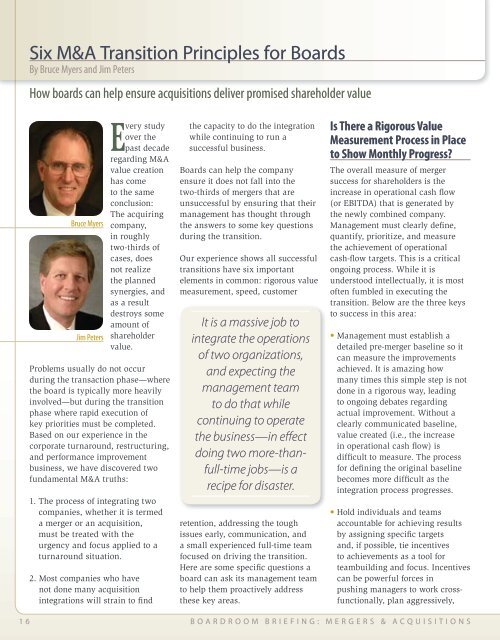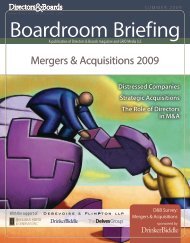Boardroom Briefing: Mergers & Acquisitions - Directors & Boards
Boardroom Briefing: Mergers & Acquisitions - Directors & Boards
Boardroom Briefing: Mergers & Acquisitions - Directors & Boards
Create successful ePaper yourself
Turn your PDF publications into a flip-book with our unique Google optimized e-Paper software.
Six M&A Transition Principles for <strong>Boards</strong><br />
By Bruce Myers and Jim Peters<br />
How boards can help ensure acquisitions deliver promised shareholder value<br />
Bruce Myers<br />
Jim Peters<br />
Every study<br />
over the<br />
past decade<br />
regarding M&A<br />
value creation<br />
has come<br />
to the same<br />
conclusion:<br />
The acquiring<br />
company,<br />
in roughly<br />
two-thirds of<br />
cases, does<br />
not realize<br />
the planned<br />
synergies, and<br />
as a result<br />
destroys some<br />
amount of<br />
shareholder<br />
value.<br />
Problems usually do not occur<br />
during the transaction phase—where<br />
the board is typically more heavily<br />
involved—but during the transition<br />
phase where rapid execution of<br />
key priorities must be completed.<br />
Based on our experience in the<br />
corporate turnaround, restructuring,<br />
and performance improvement<br />
business, we have discovered two<br />
fundamental M&A truths:<br />
1. The process of integrating two<br />
companies, whether it is termed<br />
a merger or an acquisition,<br />
must be treated with the<br />
urgency and focus applied to a<br />
turnaround situation.<br />
2. Most companies who have<br />
not done many acquisition<br />
integrations will strain to find<br />
the capacity to do the integration<br />
while continuing to run a<br />
successful business.<br />
<strong>Boards</strong> can help the company<br />
ensure it does not fall into the<br />
two-thirds of mergers that are<br />
unsuccessful by ensuring that their<br />
management has thought through<br />
the answers to some key questions<br />
during the transition.<br />
Our experience shows all successful<br />
transitions have six important<br />
elements in common: rigorous value<br />
measurement, speed, customer<br />
It is a massive job to<br />
integrate the operations<br />
of two organizations,<br />
and expecting the<br />
management team<br />
to do that while<br />
continuing to operate<br />
the business—in effect<br />
doing two more-thanfull-time<br />
jobs—is a<br />
recipe for disaster.<br />
retention, addressing the tough<br />
issues early, communication, and<br />
a small experienced full-time team<br />
focused on driving the transition.<br />
Here are some specific questions a<br />
board can ask its management team<br />
to help them proactively address<br />
these key areas.<br />
Is There a Rigorous Value<br />
Measurement Process in Place<br />
to Show Monthly Progress?<br />
The overall measure of merger<br />
success for shareholders is the<br />
increase in operational cash flow<br />
(or EBITDA) that is generated by<br />
the newly combined company.<br />
Management must clearly define,<br />
quantify, prioritize, and measure<br />
the achievement of operational<br />
cash-flow targets. This is a critical<br />
ongoing process. While it is<br />
understood intellectually, it is most<br />
often fumbled in executing the<br />
transition. Below are the three keys<br />
to success in this area:<br />
• Management must establish a<br />
detailed pre-merger baseline so it<br />
can measure the improvements<br />
achieved. It is amazing how<br />
many times this simple step is not<br />
done in a rigorous way, leading<br />
to ongoing debates regarding<br />
actual improvement. Without a<br />
clearly communicated baseline,<br />
value created (i.e., the increase<br />
in operational cash flow) is<br />
difficult to measure. The process<br />
for defining the original baseline<br />
becomes more difficult as the<br />
integration process progresses.<br />
• Hold individuals and teams<br />
accountable for achieving results<br />
by assigning specific targets<br />
and, if possible, tie incentives<br />
to achievements as a tool for<br />
teambuilding and focus. Incentives<br />
can be powerful forces in<br />
pushing managers to work crossfunctionally,<br />
plan aggressively,<br />
1 6 B o a r d r o o m B r i e f i n g : M e r g e r s & A c q u i s i t i o n s





![[link to PDF] for a copy of the briefing paper - Directors & Boards](https://img.yumpu.com/43729022/1/190x245/link-to-pdf-for-a-copy-of-the-briefing-paper-directors-boards.jpg?quality=85)







